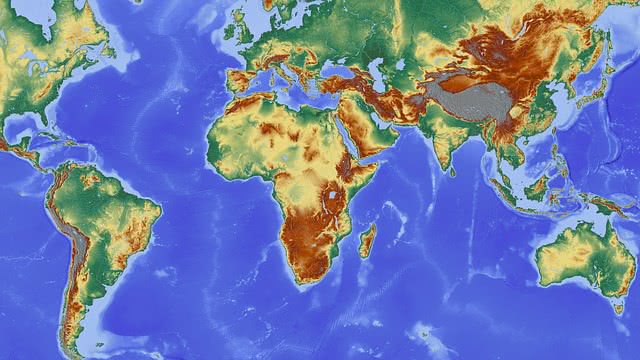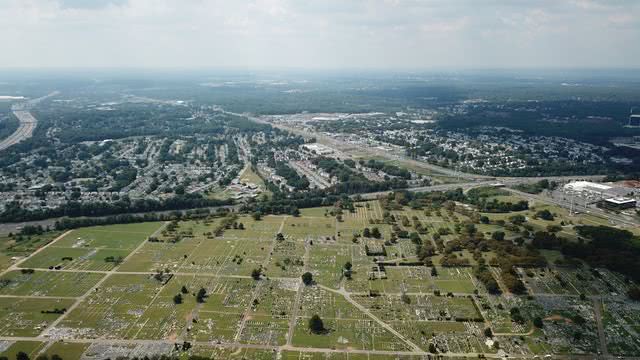A topographic map or an elevation map shows the various elevations in a region. Elevations are usually measured in meters or feet with reference to the sea level. It can be either above the sea level or below the sea level. Elevation in a map is shown using contour lines, bands of same colors or by numerical values giving the exact elevation details. A contour line connects the points in a map representing areas with the same elevation levels. The elevation maps are generally known as Topographic maps.
An Elevation Map or a Topographic Map is characterized by large scale detail that depicts a detailed ground relief, drainage, forest cover, administrative areas, transportation routes, and other man-made features.

Related: What is satellite mapping & imaging?
Topographic or elevation maps are based on large scale surveys of topography of a region showing the various elevation and landforms. The first Topographic map showing the different elevations of an entire country was completed in 1789 called the Carte géométrique de la France. The Elevation map showing the Himalayan peaks with over 100 miles distant viewpoints made in 1857 by the British Raj is believed to one of the earliest successful efforts to determine the elevations on a larger scale. These maps were prepared by the military and were considered very crucial as they were used in planning the attack strategies in war and for defensive emplacements.
Topographic maps or elevation maps gradually became essential in planning urban settlements, modern infrastructure and in planning natural resource exploitation. By 1913 there was a global effort to make the International Map of the World. In this, the land areas of the Earth’s surface area was mapped at a scale of 1:1 million spanning over a thousand sheets. By the 80’s only the coordinates were enough for even low or average skilled end users to view and print the maps. Nowadays elevation maps are made using photogrammetric of aerial photos collected using technologies like Lidar or other remote sensing techniques for large scale data. Elevation data can also be collected easily using handheld devices like GPS devices and smartphones.
The main advantage of a topographic map is that it gives a three-dimensional understanding of the terrain on a two-dimensional map. These maps are of great value for understanding the terrain for navigation and for urban planning and disaster management.
How to interpret a topographic map?
Elevation in a map can be shown using contour lines or using different bands of colors or with numerical values to indicate the height or depth. If represented in a numerical form it is definitely easy to read the map and assess the terrain. But it may frequently become difficult for a single map to show the sharp or slow gradient of the elevation. Hence in many ways, a contour map proves to be a much better solution to show the variation of elevation in an area. Here are a few pointers to interpret a contour map:
- It is important to note that all the regions that are joined by a single contour line have the same elevation.
- The area inside the contour is usually uphill. The innermost contour line represents the highest point.
- The closer the lines to each other the steeper the slope.
- Distant lines represent gradual slopes.
- While reading an elevation map it is important to make a note of the standard labeling and scale used called as the map legend or the key. The correct elevation can be calculated using the values that are given in the key
- The sharp Vs on the contour lines indicate stream with the V pointing upstream
In a color-coded map also known as a relief map, different color bands are used to represent changes in elevation. Typically, the color ‘brown’ is used to represent elevations, blue to represent water bodies, boundaries in black and grid and roads are shown in red. The color ‘green’ is used to show the presence of vegetation or terrains covered in grasslands or forest.
Related: 20 Differences between QGIS and ArcGIS
In many maps, while the color ‘brown’ is used to show elevation, the highest elevations are represented using red, white or purple. The shade of the brown used in the elevations is light in the higher elevation which then darkens as the elevation drops. Sharp slopes show a sudden change in the intensity of the shade giving a three-dimensional effect on the map.
Uses of Elevation Maps
Elevations maps have numerous uses in various fields. They not only show the terrains in an area but also give the heights of various structures which help in determining the accessibility to these areas. Here are a few of the common uses of the elevation maps;
- In geological study: The Elevation maps are very important in geology as they show the surface of the earth in detail. A 3-dimensional representation of the earth’s surface shows the patterns that help to determine the geology beneath the surface. All surface structures like hills, plateaus etc are a combined result of surface processes like erosion and sedimentation and geological processes like tectonic movements creating folds and faults, magma rising or earthquakes. By studying topography in a region scientist can determine the geological processes and predict future geological activities.

- Hazard assessment: Using the information of the Earth’s surface geologists can determine the zones of erosion and those zones that are prone to landslides and sediment accumulation. This gives a clear idea of the flow of water in case of floods so that an evacuation strategy can be designed. This is applicable for areas that are close to active volcanoes as well.
- Military: In military and defense for a country elevation maps help to analyze and determine strategic locations for watch towers, unit placements and deal with any hostiles in the vicinity. A clear understanding of the terrain will help to assess the hold and strength of an army
- Urban planning and design: Elevation maps are very crucial in planning the and designing large infrastructure. For example, construction of railway tracks; for this a very accurate understanding of the land surface will be needed. This is applicable for the water pipes, gas lines, electrical cables and placement of telecommunication towers.
- Zoning: Elevation maps are very useful in zoning a region according to the availability of its resources and its probability of hazard. For example, the zoning according to the prospect of groundwater depending on the land surface pattern and elevation or the zoning based on the availability of various minerals.
- Navigation: Elevation maps can help great deal in navigating while trekking or hiking. These maps give a good idea about the topology of the area making it possible to plan movement and camping grounds. Navigation, in general, is also helped tremendously by the elevation maps.
- Precision farming: Elevation map is an important tool for precision farming. It gives a fair idea about the type of crops that would be suitable in an area. There are different varieties of crops that are suitable for higher altitudes while others are suitable for mid to low elevation regions. For example, the High Chill variety of apples is suitable for high altitude terrains while the Low Chill variety of apple can be grown in the mid to low elevation regions. Elevation maps are also a good way to calculate the amount of fertilizer or pesticides that need to be given to a patch of crops as per the requirement of the variety.
- Contour farming: Contour farming is an established pattern of farming which utilizes elevation maps to farm mainly fruit crops in hilly areas. In this form of farming the crops are planted as per the contour lines joining the regions with the same or equal elevation. An elevation map can be used to calculate the average slope of a hill to identify the crop that would be suitable for that location. This form of farming helps in soil conservation.

Elevation maps are therefore important in all spans of technology be is military, different farming or zoning. With the help of the evaluation maps many predictions can also be done with the help of different base data and models.
Also Read: Geographic Information System (GIS) in Urban Planning
Tags: 3D Elevation Program, Digital Elevation models, Geological survey, digital elevation, elevation models, map resources, latitude longitude, leaflet maps, map elevation, topographic map